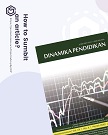Analysis of Media Use and Learning Interaction to Improving Student Engagement
(1) Universitas Negeri Padang
(2) Universitas Negeri Padang
(3) Universitas Negeri Padang
(4) STKIP PGRI Sumbar
Abstract
This research aimed to test the effect of multimedia and lecturer-student interaction on student engagement in students of the Faculty of Economics, Universitas Negeri Padang. This type of research was descriptive quantitative. The sample was taken by using the Slovin formula with 358 respondents. The measure used in the study was the likert scale. The type of data used in this study was primary data obtained through the dissemination of questionnaires to students of the Faculty of Economics, Universitas Negeri Padang. The analysis method used SEM PLS analysis using SmartPLS 3.0. The results of this study showed that: lecturer-student interaction had a significant effect on student engagement. Multimedia had a significant effect on lecturer-student interaction. Multimedia had no significant effect on student engagement. The implication of this study was that empirically in learning that online student interaction was very necessary in order to increase student involvement in learning. Then, the use of multimedia affected student involvement in learning. The future research agenda needs to study more deeply the use of multimedia on student involvement in learning.
Keywords
Full Text:
PDFReferences
Alabdulkareem, S. A. (2015). Exploring the use and the impacts of social media on teaching and learning science in Saudi. Procedia-Social and Behavioral Sciences, 182, 213-224.
Allen, W. R., Comerford, R. A., & Ruhe, J. A. (1989). Factor analytic study of Bales’ interaction process analysis. Educational and Psychological Measurement, 49(3), 701–707.
Anwar, M. S., Choirudin, C., Ningsih, E. F., Dewi, T., & Maseleno, A. (2019). Developing an interactive mathematics multimedia learning based on ispring presenter in increasing students’ interest in learning mathematics. Al-Jabar: Jurnal Pendidikan Matematika, 10(1), 135-150.
Baanqud, N. S., Al-Samarraie, H., Alzahrani, A. I., & Alfarraj, O. (2020). Engagement in cloud-supported collaborative learning and student knowledge construction: a modeling study. International Journal of Educational Technology in Higher Education, 17(1). https://doi.org/10.1186/s41239-020-00232-z
Birch, C., Lichy, J., Mulholland, G., & Kachour, M. (2017). An enquiry into potential graduate entrepreneurship: Is higher education turning off the pipeline of graduate entrepreneurs? Journal of Management Development, 36(6), 743–760. https://doi.org/10.1108/JMD-03-2016-0036
Bond, M. (2020). Facilitating student engagement through the flipped learning approach in K-12: A systematic review. Computers & Education, 151, 103819.
Cho, H. J., Levesque-Bristol, C., & Yough, M. (2022). How autonomy-supportive learning environments promote Asian international students’ academic adjustment: a self-determination theory perspective. Learning Environments Research, 1–26.
Cole, M. T., Shelley, D. J., & Swartz, L. B. (2014). Online instruction, e-learning, and student satisfaction: A three year study. The International Review of Research in Open and Distributed Learning, 15(6).
Dharmayana, I. W., Kumara, A., & Wirawan, Y. G. (2012). Keterlibatan siswa (student engagement) sebagai mediator kompetensi emosi dan prestasi akademik. Jurnal Psikologi, 39(1), 76-94.
Fatimah, S., & Cangara, H. (2016). Pemanfaatan Saluran Komunikasi Dalam Penyerapan Aspirasi Masyarakat Oleh Pusat Pelayanan Informasi Dan Pengaduan (Pindu) Pemerintah Kabupaten Pinrang. KAREBA: Jurnal Ilmu Komunikasi, 79–91.
Hasan, I. (2017). Contextual video: Critical thinking-based learning media in the implementation of curriculum 2013. Dinamika Pendidikan, 12(2), 136–147.
Howe, C., Hennessy, S., Mercer, N., Vrikki, M., & Wheatley, L. (2019). Teacher–student dialogue during classroom teaching: Does it really impact on student outcomes? Journal of the Learning Sciences, 28(4–5), 462–512.
Kahu, E. R., & Nelson, K. (2018). Student engagement in the educational interface: Understanding the mechanisms of student success. Higher Education Research & Development, 37(1), 58–71.
Khan, M. A., Nabi, M. K., Khojah, M., & Tahir, M. (2020). Students’ perception towards e-learning during COVID-19 pandemic in India: An empirical study. Sustainability, 13(1), 57.
Kuswoyo, K., Hidayah, N., & Diponegoro, A. M. (2021). Pengaruh Komunikasi Interpersonal Guru, Student Engagement dan Efikasi Diri terhadap School Well-Being Siswa SMPN 1 Semanu Kabupaten Gunungkidul. Jurnal Syntax Transformation, 2(3), 342–353.
Liu, H., Tian, Y., Yang, Y., Pang, L., & Huang, T. (2016). Deep relative distance learning: Tell the difference between similar vehicles. In Proceedings of the IEEE conference on computer vision and pattern recognition (pp. 2167-2175).
Mayer, R. E. (2019). Thirty years of research on online learning. Applied Cognitive Psychology, 33(2), 152–159.
Melati, I. S., & Harnanik, H. (2021). An analysis of student engagement for online microeconomics class based on ELED. Dinamika Pendidikan, 16(1), 33-43.
Misra, F., & Mazelfi, I. (2021). Long-distance online learning during pandemic: the role of communication, working in group, and self-directed learning in developing student’s confidence. Proceeding of the 3rd International Confeerence on Educational Development and Quality Assurance (ICED-QA 2020), 506, 225-234.
Mustofa, M. I., Chodzirin, M., Sayekti, L., & Fauzan, R. (2019). Formulasi model perkuliahan daring sebagai upaya menekan disparitas kualitas perguruan tinggi. Walisongo Journal of Information Technology, 1(2), 151–160.
Muthuprasad, T., Aiswarya, S., Aditya, K. S., & Jha, G. K. (2021). Students’ perception and preference for online education in India during COVID-19 pandemic. Social Sciences & Humanities Open, 3(1), 100101.
Näykki, P., Järvelä, S., Kirschner, P. A., & Järvenoja, H. (2014). Socio-emotional conflict in collaborative learning—A process-oriented case study in a higher education context. International Journal of Educational Research, 68, 1–14.
Nuraisyah, S., Harahap, R. D., & Harahap, D. A. (2021). Analysis of Internet Media Use of Student Biology Learning Interest During COVID-19. Jurnal Penelitian Pendidikan IPA, 7(2), 213-217.
Paquette, P. (2016). Instructing the instructors: Training instructors to use social presence cues in online courses. Journal of Educators Online, 13(1), 80–108.
Primamukti, A. D., & Farozin, M. (2018). Utilization of interactive multimedia to improve learning interest and learning achievement of child. Jurnal Prima Edukasia, 6(2), 111-117.
Proto, E., Rustichini, A., & Sofianos, A. (2019). Intelligence, personality, and gains from cooperation in repeated interactions. Journal of Political Economy, 127(3), 1351–1390.
Rhode, J. (2009). Interaction equivalency in self-paced online learning environments: An exploration of learner preferences. The International Review of Research in Open and Distributed Learning, 10(1).
Sarafino, E. P., & Smith, T. W. (2014). Health psychology: Biopsychosocial interactions. John Wiley & Sons.
Sardiman, I. (2012). motivasi Belajar Mengajar Jakarta: PT. Raja Grafindo Persada.
Smith Jr., A. R., Cavanaugh, C., & Moore, W. A. (2011). Instructional multimedia: An investigation of student and instructor attitudes and student study behavior. BMC Medical Education, 11(1). https://doi.org/10.1186/1472-6920-11-38
Strauß, S., & Rummel, N. (2020). Promoting interaction in online distance education: designing, implementing and supporting collaborative learning. Information and Learning Science, 121(5–6), 251–260. https://doi.org/10.1108/ILS-04-2020-0090
Vuopala, E., Hyvönen, P., & Järvelä, S. (2016). Interaction forms in successful collaborative learning in virtual learning environments. Active Learning in Higher Education, 17(1), 25–38.
Yustika, G. P., & Iswati, S. (2020). Digital literacy in formal online education: A short review. Dinamika Pendidikan, 15(1), 66-76.
Zhu, E. (2006). Interaction and cognitive engagement: An analysis of four asynchronous online discussions. Instructional Science, 34(6), 451–480.
Refbacks
- There are currently no refbacks.

This work is licensed under a Creative Commons Attribution 4.0 International License.

.png)

.png)





